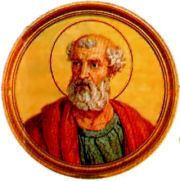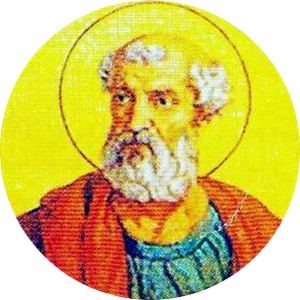Papacy began c. 140 Name Pope I Feast day 11 July | Birth name Pius Papacy ended c. 155 Role Bishop of Rome Siblings Hermas | |
 | ||
Similar People Pope Alexander I, Pope Sixtus I, Pope Anastasius I, Pope Felix III, Pope Anicetus | ||
Pope Saint Pius I (died c. 155) is said to have been the Bishop of Rome from c. 140 to his death c. 154, according to the Annuario Pontificio. His dates are listed as 142 or 146 to 157 or 161, respectively.
Contents

Early life
Pius is believed to have been born at Aquileia, in Northern Italy, during the late 1st century. His father was an Italian called "Rufinus", who was also a native of Aquileia according to the Liber Pontificalis.
According to the 2nd century Muratorian Canon and the Liberian Catalogue, that he was the brother of Hermas, author of the text known as The Shepherd of Hermas.
The writer of the later text identifies himself as a former slave. This has led to speculation that both Hermas and Pius were freedmen. However Hermas' statement that he was a slave may just mean that he belonged to a low-ranking plebeian family.
Pontificate
According to Catholic tradition, St Pius I governed the Church in the middle of the 2nd century during the reigns of the Emperors Antoninus Pius and Marcus Aurelius. He is held to be the ninth successor of Saint Peter, who decreed that Easter should only be kept on a Sunday. Although credited with ordering the publication of the Liber Pontificalis, compilation of that document was not started before the beginning of the 6th century. He is also said to have built one of the oldest churches in Rome, Santa Pudenziana.
Saint Justin taught Christian doctrine in Rome during the theoretical pontificate of St Pius I but the account of his martyrdom indicates there was no Roman bishop present there. The heretics Valentinus, Cerdon, and Marcion visited Rome during that period. Catholic apologists see this as an argument for the primacy of the Roman See during the 2nd century. Pope Pius I is believed to have opposed the Valentinians and Gnostics under Marcion, whom he excommunicated.
There is some conjecture that he was a martyr in Rome, a conjecture that entered earlier editions of the Roman Breviary. The study that had produced the 1969 revision of the General Roman Calendar stated that there were no grounds for his consideration as a martyr, and he is not presented as such in the Roman Martyrology.
Feast day
Pius I's feast day is 11 July. In the Tridentine Calendar it was given the rank of "Simple" and celebrated as the feast of a martyr. The rank of the feast was reduced to a Commemoration in the 1955 General Roman Calendar of Pope Pius XII and the General Roman Calendar of 1960. Though no longer mentioned in the General Roman Calendar, Saint Pius I may now, according to the rules in the present-day Roman Missal, be celebrated everywhere on his feast day as a Memorial, unless in some locality an obligatory celebration is assigned to that day.
